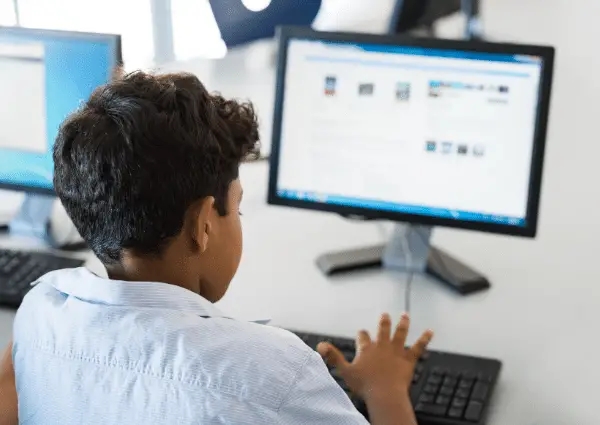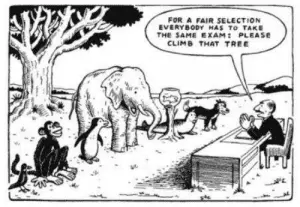There is so much written word in the world, it would seem almost insurmountable to figure out if your student copied and pasted their assignment.
Back in the day, it would be pretty easy to look at a student’s assignment and recognize if it had been plagiarized. Words and phrases that didn’t sound like the student, were way above their knowledge level, or that you had actually read from your own experience would be pretty quick giveaways.
But in today’s world, there is so much writing everywhere, but especially online. While you may recognize plagiarism from texts and other books as well as reports and articles online, it would be impossible to recognize work that your student copied and pasted from all of the articles and resources now found online.
So how do I answer the question, “Did my student copy and paste?” There are several incredibly reliable plagiarism checkers online that you can use. And the vast majority of them are free! But there are also clues you can pick up on that indicate plagiarism has occurred. Yet another form of plagiarism you may discover is students outsourcing their assignments. And finally, as a student, you can use these resources to determine if you have accidentally plagiarized.
I created the following graphic to help you make sure that the answer to “Did my student copy and paste” is not a problem in your classroom. (And if it IS a problem, you can take care of it before it becomes a large problem.)

Table of Contents
Make Sure Your Students Understand Plagiarism
Often students don’t realize that most of what they see online is not theirs to cut and paste. We live in a time when sharing on social media is constant. So it becomes very natural for students to also think its okay to cut and paste from their research online. Because they don’t have to cite what they’re putting on Facebook, Instagram, Snapchat, and whatever else they are using, it never occurs to them that their research assignment needs citations.
As soon as you start teaching your students research, you need to set aside time to explain plagiarism and citations. After a few practice runs with how to format citations based on the media you are using, your students will be able to easily do it.
Note: This does not get into the 3 major styles of citations–Chicago, Modern Language Association, or American Psychological Association. That will be a lesson for another day. This is referring to citations for research papers vs. citations for websites, videos, tweets, or whatever resources they are using.
Having a reference form available for them to keep in their binders will be a huge step in conquering the ” did my student cut and paste” fear that many teachers have and hate to deal with.
The guide I used for my students was and amazing resource on Mendeley. They show how to do many different citations based on APA, MLA, and Harvard methods.
7 Clues That Your Student is Cutting and Pasting
There are lots of different ways to know if your student cut and pasted their work. Some of them come down to knowing your students and the ways that they tend to communicate. But many of them are based on anomalies found in the format of the report they turn in. Here is a good guide to get you started. I think that once you work with these, many others will become obvious to you over time as well.
1. If the Wording is Not the Way Your Student Tends to Communicate.
This one is hard to pin down if it is the beginning of the year or for whatever reason, you just don’t know the student very well. It can also be tricky because as our students learn and develop over the year, their communication skills will improve and become more nuanced. So this is not necessarily an indicator or plagiarism. It could very well be development over time.
The red flag would be if you see a huge overnight difference in your student’s communication skills. Then I would at least start looking into it.
2. If Students are Unable to Express The Concepts They Wrote About
If your students cannot give at least a rudimentary explanation of what they wrote about once they have turned in their assignment, it is a good possibility that they copied and pasted what is in their assignment.
It could also be that the student worked on the assignment minimally and put it together in a rush, learning little to nothing from it. That is not much better than plagiarism, and it is something you will need to address. But at least it isn’t illegal!
Regardless of the the details regarding why your student cannot communicate the material (s)he wrote, you will need to investigate to solve the problem.

3. Certain Paragraphs or Passages are Inconsistent in Tone
If there are certain sentences, paragraphs, or passages that have a completely different tone or even theme from the rest of the work, it is very possible that it is due to student cut and paste activity.
Especially as students are learning to write, consistency in tone may not be overly consistent, but it will not be as obviously out of place as when a student has copied and pasted from other works online. That will be an obvious tip off to you to look into the matter.
4. Abrupt Changes in Person
Again, this is not necessarily something that young writers will be totally consistent with. But it will be obvious if the general tone is, for example, written in first person and then for just one isolated paragraph it is written in second or third person.
When students are learning to write and do research, you will definitely see inconsistencies in person. But the difference here is that if you find writing in which the person is consistent throughout except for the one section, you will probably want to look into it a bit more.
5. Subtle Changes in Font
Few students of any grade will cut and paste other materials in an obvious way. They certainly will not use significantly larger or bolder print. And you aren’t going to see drastically different font styles, which you generally wouldn’t see anyway because font styles for most online reports and articles are pretty similar.
What you will catch is very subtle changes in font that are just a small amount of the assignment–a paragraph or two generally. It could be just a font size of one or two points more or less. Or it could be one of a number of very similar fonts to Times New Roman for example.
The problem you will have with this is that the vast majority of us would not necessarily pick up the difference between these fonts because they are so similar. Here is an example of text from an excerpt of The Magician’s Nephew by C.S. Lewis:

While the first paragraph was written in Times New Roman with a font size of 11, the second paragraph was written in Calista with also a size 11 font. They are virtually indistinguishable. So unless cutting and pasting is coming from a blog post or other different format, many times you will not necessarily see this kind of plagiarism on first glance.
But on occasion, you may have the student that doesn’t really care enough to change an obviously different font. And honestly, in those cases, students are probably unaware that they are breaking any copyright laws, hence the lack of trying to hide it.
6. Bizarre Dates or Events in Plagiarized Content
Occasionally, you will have a student write an assignment and cut and paste material that clearly doesn’t fit into the time frame and events of what they are supposed to be writing.
For example, if a student is writing a piece on current unrest in the world right now and you find a section talking about injustices in Bosnia, especially in the early 1990’s, you probably have some plagiarism issues to deal with.
While a student can certainly reference the Bosnian conflict in an assignment for today’s world, it would be more of an example, a passing reference, or other such mention, and not a part of the narrative that the student is trying to communicate.
It will definitely be obvious to you if a part of an assignment is cut and pasted vs. a part of the actual assignment in these cases.
7. Lack of a Consistent Theme in Plagiarism
In this case, you may have a student that does pretty well in tying down the theme of most of the assignment, but one or two sections just seem drastically out of place with the rest of the topic.
Or it could be that the whole thing is all over the place. While it could just be a matter of a student that doesn’t do a great job of sticking to the subject and developing it, it could also be that they are cutting and pasting from various sources to get the assignment done without putting any significant work into it.
As you get to know your students, this will actually be one of the easiest ways to determine if your student cut and pasted.

Some Free Plagiarism Checker Options
I had a hard time finding plagiarism checkers that were actually free. Most of the articles that featured free plagiarism checkers were capitalizing on the fact that there were free trials. The following list are actually free and not trials!
But in order to do that, do we have to sacrifice quality? It actually does seem so to a degree. There are a couple of okay options for free. Unfortunately, you or your school will have to shell out some money in order to get a really good plagiarism checker.
That being said, let’s take a look at the free options that do a decent job even if they can’t catch everything!
1. Quetext
Quetext is a copy and paste plagiarism checker. It is super easy to use because of this, but you can’t upload large documents to check.
So I tested it out with a guest post from my site. How do you think it fared?
Actually it did an excellent job! I copied and pasted one paragraph from the article and it immediately picked up on an original article by my guest poster. Fortunately, I won’t be in any trouble for it since my article explicitly states that I had permission from the author and she even included a short blurb in the original article referencing back to mine.
So I decided to try one obscure paragraph from one of my own articles. And sure enough, it pointed right back to my site!
The one thing that it did insist was that after I did the first check, it made me register for free for the second one. But the fact that it picked everything up immediately was enough for me to be willing to give them my info!
It also gave (in both cases) a 100% chance of plagiarism rating, which was absolutely correct.
The final test I gave it was a copy/paste of this article before being published. It took a bit longer, maybe because there was no obvious plagiarism. It did give me a rating of 20% chance of plagiarism for the following two phrases:
One final plus was that it only took a few seconds to complete the search.
However, I did not try to do any extensive articles.
It said the first one could have come from a website called “Ilovefreesoftware.com” and the other one was attached to a trip advisor review. Since it is easy to see that both are random associations and not plagiarism, it was a good report.
One final plus was that it only took a few seconds to complete the search. However, I did not try to do any extensive articles.
I was pretty thrilled with its performance though!
2. PlagTracker
After how much I loved Quetext, I almost didn’t want to check this one out. That probably would have been fine because after accessing the site, I found it significantly less user friendly than Quetext. I copied and pasted one of the same paragraphs as above to get a good comparison. And I couldn’t get it to initiate the search.
What I did get was the following page:
It first of all requires a subscription in order to get any results. And it also instructed me to email them in order to get the ball rolling. It turned out to be not user friendly at all. And as a result, I got no results.
I tried the site owners and students options and got this same result. And when I tried to click on the publishers and teachers options, I got a URL not found error on both of them.
Reviews also say that it gets a ton of false positives. That was enough for me to realize I would be wasting my time with this one.
Maybe if the sign up process was easier, I would have found a more intuitive program. But I just didn’t get that far.
3. Plagiarism Detector
The final one I tried was Plagiarism Detector.
It was super easy to use. I immediately saw the box to copy and paste and started with the same paragraph from one of my published posts. After a few seconds, it came back as 100% plagiarized but didn’t give me any sources to say what it was plagiarized from.
So then I took the same excerpt from this pre-published article that I used above. That search came back a few seconds later saying 100% not plagiarized. I was satisfied with that since I was writing that I had literally just typed and not published yet. It also didn’t get the same hits as Quetext, but since even Quetext was just claiming similarities and not plagiarism, I was content with both results of both sites.
4. Google
Of course, googling your text is also a great way to check on suspected plagiarized texts. Google literally has the largest database on the internet, so it would be a valid search.
The one disadvantage to Google is that you can’t necessarily cut and paste a huge amount of text. But it certainly works quickly and efficiently for a small portion of text that you want to check on briefly.
The Verdict
So after reviewing these options, what would my recommendations be? I would definitely use Quetext first, both because of it’s ease of use and it produces sources of plagiarized text. But Plagiarism Detector is a close second and certainly worthwhile. And Google will always be a great quick option.
The one thing that I was unable to do was determine if private articles and non-public texts were identifiable. And for those, it largely depends on if companies have permission from the author to determine that. This is same for even paid plagiarism checkers as well, so I don’t necessarily see this as a detriment. This is especially true since I am not evaluating college level assignments.
The bottom line here is that we have some excellent options that are free and easy to use!
How Students Can Make Sure They Have Not Accidentally Plagiarized
It is pretty imperative that students learn from an early age that plagiarism is a serious issue. Teaching them that copying and pasting without giving credit where it is due is a huge problem will help to encourage them to not do it.
Another great way to discourage them from copying and pasting is to show them how a plagiarism checker works. They will first of all be pretty amazed at how easy it is. Then they will be struck with how easy it will be for them to get caught!
There are a few times, as I referenced above, that original work can be close enough to other writing that it gets a possible hit for plagiarism. And that is fine as long as it is kept in proper perspective.
A great way to help students to check their own work is to have a station in your classroom with a tablet or small laptop notebook that will allow students to check their own work before turning it in. Having the sites ready to go makes it even quicker and easier. And it could be a ground breaking advantage for your students as they navigate the world of writing.
Conclusion
So this is how to find out the answer to the question, “Did my student copy and paste?” It also gives some great advice on making sure our original work actually is original. It is a great tool for all of us to use as we are constantly improving our work in the world.
How have you dealt with the issue of students copying and pasting in your classroom or homeschool? I would love to hear your input. Feel free to comment below!
If you loved this article, I think you will also love the following articles:
How to Teach Students to Summarize the Right Way
Unique Classroom Ideas: Get Your Students Published!
Encouragement for Those Who Will be Homeschooling Through Covid-19





Indeed with these lessons in streaming, which I do not love at all, this danger is around the corner. How do teachers notice. Really interesting blog post, even for parents.
Yes, Cristina! Where there’s a will there’s a way for kids to get around the rules. And right now you are right that it is easier than ever. Teaching them the right way and the risks is a good way to circumvent a good amount of it!
I will be starting to teach at private school in a month or two, just waiting for directives on the current pandemic. I will try the list of plagiarism checkers ones I start teaching. It is good to know this ahead of time. Thanks
I am glad this was helpful to you, Kingsley! Congrats on the new job and stay safe! ♥
I’m sure all kids have done it at some time, it never pays off though and always best to catch them out if you can. Good tips to watch for.
As a young student, I would take resources and re-word them to make them my own writing. As I got older I learned to develop my own style. But I wonder how much of that would be considered plagiarism now. I think many kids do it unintentionally, or just don’t realize how it works. Thank you for sharing your thoughts, Fiona! And I do think you are right that most if not all kids have done it at some time, intentional or not.
Glad that there are now tools to make it easier for teachers to check. I’ve had classmates when I was still in school who got caught plagiarizing!
I know a couple of students that got caught as well. One was a straight A student. She ended up confessing before getting caught and because of it I think they worked it out favorably for all. Thank you for sharing, Meki!
This is such a great article to read by my friend who is also an educator. I am pretty sure that all students are doing this thing but this post will help her know if her students are doing a copy, cut and paste with their works.
Thank you for sharing with her, Gervin. I think many students cut and paste, not realizing they need to give credit to the source or come up with their own reports.
I may say that this is very essential today as we’re on the new norm of online schooling. We need our student to learn the important of plagiarism and make them be responsible and respect other’s work.
You are absolutely right about this!
I remember being in school and it being drilled into us how bad plagiarism is and how you always always always must cite sources. This is SO important.
I do remember this being addressed repeatedly around 4th or 5th grade. I think because that is when kids just naturally start doing it, not necessarily realizing that they are wrong for doing it. I think it is even more critical now in the digital world we live in. Thank you for sharing your thoughts! ♥
I would have never thought about kids plagiarizing! But it is definitely a concern, thanks for the wonderful tips!!
I love this! Students will never learn anything if they take the copy and paste approach. Well covered with a solid solution. I have many TEFL teacher friends that I’d like to share this with. Thanks for this.
Thank you for sharing, Piper. And you are so right that there is no learning involved in just cutting and pasting!
Some students cheat knowing that they’re cheating but others do it without knowing it is actually plagiarism. I love what you said about explaining to the student what is considered plagiarism and what is not.
Thank you, Chad! And I agree that most kids probably don’t even realize that they are doing wrong. Educating them about what the right procedures are will help take that problem out of the mix.
It’s inevitable that some students do it. We use an app at school to check plagiarism. This is to give merits to those who really did their assignment.
This is awesome, Emman! I am glad that your school systems are working with it.
copying and pasting will not improve students knowledge…glad you shared such helpful information with us..great work though..these tips and ideas are definitely going to be very useful one too…
Good point about making sure the students know what plagiarism is in the first place. The whole time I was reading about it, I thought, you can just “google” the paragraph to check, and then sure enough you listed it as a resource, haha. Great to know there are other sources to use as well.
Is it bad that I am actually glad I was predictable in this case, lol?
This is such an important post for teachers to read in this modern age. With so much out there on the internet, it’s super easy for kids to copy/paste and just bank on the fact that there’s so much out there the teacher won’t notice.
They won’t get away with that mentality for long in this world! But that is also why training is imperative so they know before they attempt it!
I hate to say it, but I was one of those copy/paste kids in school. Back then, the internet was so new, it was really hard for teachers to spot it. Great post.
Thanks, Bill. I think when the internet was new a lot of younger people thought it was just fine to cut and paste without thinking about consequences or the significance of what they were doing.
It’s amazing how much things have changed over the years. When I was in high school, I knew a lot of kids who just recycled other work, and they never got caught. I’m so glad teachers are able to catch it now. Kids only cheat themselves when they do this.
You are so right, Brianne. Even if they got away with it, they didn’t learn anything so it was still a huge waste of whatever time they invested in working it all out.
It’s so difficult to find original book nowadays because of anything it’s great that you can teach us how to distinguish everything.
Plagiarism is a plague and students are getting caught up in it.
We all love a good dose of originality, creativity and most of all doing their best!
I agree, Rosy. We need creativity and originality! That is what keeps the world moving! Thank you for your thoughts.
As an English Language Arts teacher, you become attuned rather quickly to this problem! I will have to check out some of your suggestions of plagiarism trackers. Thanks for sharing!
I hope you find them helpful, Angel! Thank you for sharing your thoughts. ♥
Plagiarism checker is a huge thing. Its really not acceptable when they do that.
Plagiarism is such an important concept especially now that so much information is available online. Many students think that copy and paste is Ok. Great article.
Thank you, Norma!
These are surely helpful tools and platforms to check for plagiarized work. Makes it a lot easier to spot when it has been committed.
Very true, Lucy. It would be impossible to do otherwise.
Plagiarism is such a big issue in schools because a lot of students may think that they can cut corners instead of doing the actual work. It’ll hinder them from actual learning and growth. That’s why it is so important for teachers to be able to catch if a student is copying someone else’s work.
I could not have worded that reply any better, Jasmine! You hit the nail on the head. Thank you for your thoughts. ♥
Wow! Such great & helpful tips to help teachers detect plagiarism, Bravo 🙌🏻
Thank you, Romy.
These are great tips. I wpuld definitely follow these if I was a teacher.
Hihi….you just caught me with the pointer about changing of person. It always sells us out.
Really enjoyed the post. First things first: the student have to know about plagiarism, and why it is important to do otherwise.
Prevention of plagiarism is talking about it and showing examples of it. And stating a fact that our own thoughts are of value.
Those are all the great tips to find copy, paste from students. Especially with the support of plagiarism tools, the process is much more easier now.
Everything is very open with a very clear explanation of
the issues. It was truly informative. Your website is very helpful.
Thanks for sharing!